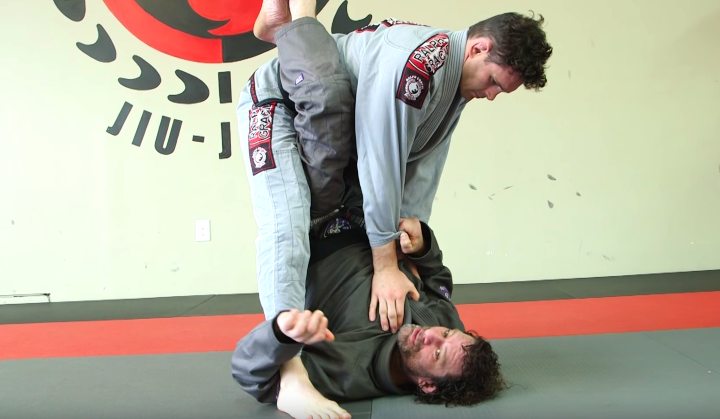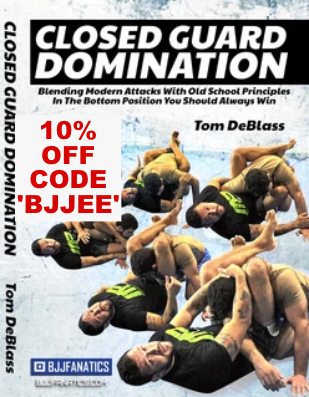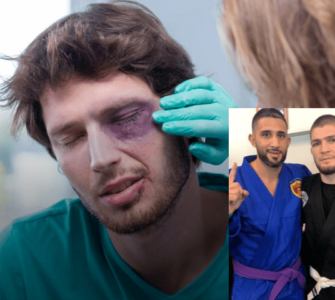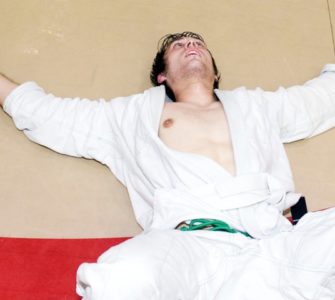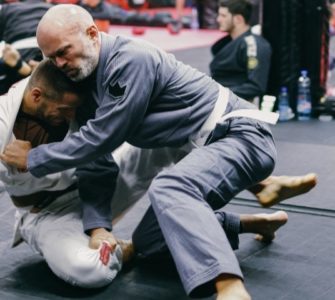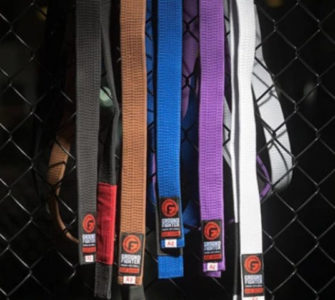In the previous article of our Weekly White Belt Advice series, we’ve talked about the very basics of the closed guard – what it is, its defensive and offensive purpose and the body positioning. What’s more, we’ve also emphasized the importance of breaking the opponent’s posture – because of its utility for both submitting your opponents, as well as for sweeping them.
In this article, we’ll look at some of the fundamental things that concern sweeping your opponent from the closed guard position.
What is a „Sweep“ and What is It Used For?
What is a sweep, anyway? In BJJ, sweeps are techniques used for reversing one position into an another one – a more advantageous one for the jiujiteiro who performs the sweeping technique.
Certainly, the closed guard is already advantageous for the practitioner that holds it. However, Jiu Jitsu is a dynamic game that asks from its competitors to always be on a lookout for and hunting for more dominant positions; from which they can then utilize and finish a submission or, simply, gain more points.
That is why it is of immeasurable importance to learn how to sweep opponents from all possible positions, as well as closed guard. But, before we get to the details, we need to understand that breaking your opponent’s posture greatly aids your ability to sweep him.
Breaking the Posture as The Most Desirable Position For Sweeping
You’ll find that you will have the most amount of success with your sweep attempts when you have broken down your opponent’s posture; something which we’ve learned how to do in the previous article.
And why is it so? Simply put, it is more desirable to have them with their back rounded and their weight shifted forwards, as this is a deficient and more off-balanced body position where they have to use a lot more of their energy to defend from your sweeps and attacks than it would be the case otherwise.
So, you’ll do most of your sweeps when your opponent’s posture is broken down: sometimes you’ll first break their posture and only then go into a concrete sweep setup – and sometimes you’ll be breaking the opponent’s posture during or after you’ve started setting the sweep already.
However, you can also sweep them when they have „good“ posture: when their backs are straight and neck upright.
As you can probably guess, there are many possible options and variations of sweeps. But, before we learn some of them, let’s first understand the general body positioning used when setting up and performing sweeps.
General Body Positioning
In regards to positioning your body when going for a sweep, remember that – as in almost all Jiu Jitsu-related things – there are no all-encompassing details that you can learn and use immediately. Instead, let’s focus on general guidelines which are true most of the time, and which we’ll see at work in their various combinations on the videos below.
Hips Positioning
Much of what we’ve learned about hip positioning in the previous article also holds true when you’re looking to sweep your opponent:
1) Your hips must never be flat. Keep them off the ground, as this makes it easier for you to work for angles.
2) Angles, angles, angles. You must always be on the search for favorable angles that will make it possible for you to sweep your opponent. Of course, a specific sweep will require a specific position and angle of attack, but the principle remains the same – be active and never let your hips be square with your opponent’s.
Legs Positioning
You will be using your legs for three following purposes:
1) To off-balance your opponent by utilizing the movement of your legs – such as when using the pendulum movement in the „flower sweep“.
2) To off-balance your opponent by utilizing the combination of base and strength of your legs – such as when going for the „hip bump sweep“.
3) To trap the opponent’s own leg – done on the same side that you’re performing your sweep on, so that he cannot use his own leg to prevent you from finishing the sweep.
These three are mostly used in a combination with each other.
Arms Positioning
The way you place your arms will greatly influence the success rate of your sweeps. But, what do you actually use them for when you sweep?
1) Your first arm’s objective is to put your opponent’s arm into a position that is insufficient for posting. In other words, you want to render their arm incapable of posting and retaining balance once they’re being swept.
This is mostly done in two ways:
- By pulling their arm across the center line of your torso (just imagine a straight line going across the middle of your torso and down towards your feet – that is the center line) and then trapping it. This is usually done by gripping their sleeve/wrist and by aiding yourself with the second arm (such as by grabbing their arm below the elbow, to further facilitate the pulling motion), after which you keep their arm in place (for example, with the help of their own bodyweight making pressure on top of it).
- By immediately trapping their arm (by grabbing and pinching their sleeve in place or by using an overhook, for example).
2) The second arm’s objective is to assist. This means that, while your first hand is busy with trapping the opponent’s arm, your other arm will be making adjustments which will make the sweep work (better).
The way you place this arm greatly depends on the position you’re looking to sweep from. For example, it can be used to shoot below and elevate your opponent’s leg in order to shift his bodyweight; as well as in the already mentioned scenario – when it is „helping“ your first hand in pulling your opponent’s arm across the center line, done by placing it behind his elbow and pulling it.
So, we have seen the general guidelines that you should follow in almost all cases. Now is the time to see those guidelines in work; to understand and practice a couple of actual sweeps.
The Most Important Thing to Know: Take Advantage of Your Opponent’s Bodyweight Distribution
However, before that, let’s take a moment and remind ourselves again: the sweep’s primary purpose is to position yourself in a more advantageous position than it was the case before. There are a few positions that you can sweep your opponent into in order to gain an upper hand and score more points. In terms of closed guard sweeps, however, we’ll focus almost solely on how to sweep your opponent into the mount.
This is done both because of the extremely dominant nature of the mount position, which is second only to the backtake (which we’ll take a brief look at in the „Closed Guard Submissions“ article) and because you’ll find that the vast majority of sweeps from closed guard will lead to the mount.
But, how will you know when to go for a specific sweep, rather than another one? The answer is simple.
Understand this: when your opponent is in your closed guard, he can distribute his bodyweight in three different ways – forwards (towards your torso), backwards (away from you) and „upwards“ (by standing up and moving the bodyweight up from you). The type of a sweep that you’ll choose to perform depends on the way your opponent distributes his bodyweight.
So, let’s divide the video examples of the sweeps you’ll see into three different categories: 1. „Bodyweight is Forward Sweeps“; 2. „Bodyweight is Backward Sweeps“; and 3. „Opponent Stands Up Sweeps“.
As said, you’ll see that the majority of them will lead to you ending up in the powerful mount position.
Bodyweight is Forward Sweeps
Bringing your opponent’s bodyweight towards you – through breaking his posture – is the most desirable way for you to set up sweeps in closed guard.
This is much better than having his weight backwards, as you control over a larger percentage of his body and a much closer proximity to his limbs (that is, a much higher possibility of trapping them and rendering them useless). Remember: when you’re attacking, the more of a control and proximity you have over your opponent’s body and his limbs – the more dangerous you will be.
Therefore, we’ll mostly look at examples of this „category“ of sweeps.
The Flower Sweep
The flower sweep is a relatively simple sweep that has a lot of variations, and is used on all levels of competition – from white to black belt level. So, it pays to learn it and experiment with it often in your training.
In the video above, Professor Gustavo Gasperin points out several important details for making this sweep into a success. Watch the video carefully, search for these points and use them in practice.
Points:
–>Observe how he traps his training partner’s arm by gripping his sleeve (and then pinching his own elbow to the ground, so as to make the grip more difficult to break). He does this in order to prevent him from posting on that arm and from maintaining balance once when the sweep is performed.
–>Watch how he uses his other arm to grab the bottom of training partner’s pants, in order to aid the movement necessary for the sweep by lifting that leg higher off the ground once the sweep is performed.
–>Notice how he shifts his hips to the left, in order to create a necessary angle for the sweep (and in order to make it easier for himself to grab the training partner’s pants).
–>Watch how he blocks his partner’s leg (the one on the same side as the arm he has trapped) with his own leg, in order to make him incapable of posting on it once when the sweep is performed.
–>Observe how he lifts his hip to initiate the sweep and how he drives his other leg under his partner’s armpit, in order to generate movement.
Flower Sweep Variation
We’ve said that there are a lot of flower sweep variations, haven’t we? This one is a No Gi version; keep your eyes on the important points that make it work.
Points:
–>Notice the difference in using the legs, in comparison to the first variation of the flower sweep: the opponent’s leg is not trapped, but your legs work together in order to create a simple pendulum motion.
–>Notice that he shifts the training partner’s arm across the center line of his torso, in order to make him incapable of posting on it when the sweep is performed. He does this by grabbing the partner’s wrist first, and then by using his other hand to grab behind the partner’s elbow (which is a very strong grip) in order to pull his arm across the center line.
–>Observe how he breaks the training partner’s posture by pulling the knees towards himself.
–>Watch how he scoots his hip out in order to create a bit of space. This makes it a good position for him, as he has trapped the partner’s elbow as well.
–>Notice how he keeps his training partner’s posture down by reaching across his back and grabbing his lat muscle – underneath his armpit.
–>Observe that he reaches below his partner’ leg with his other arm, in order to create a favorable angle and to lift his leg once the sweep is performed.
–>Watch the movement of his legs; how he opens them up and uses one of his leg in a pendulum-like movement, with the other leg aiding that movement, in order to sweep his training partner and get him into a mounted position.
The Pocket Sweep
The Pocket Sweep is an another easy to learn and use technique, which you will carry with yourself through the upcoming years of training.
Points:
–>Notice when and how he breaks, and then keeps the training partner’s posture down. He does so after establishing the grip first – sometimes you’ll have to deal with the grips first, and only then will you be able to break their posture down.
–>Observe how he moves his partner’s arm across the center line of his torso, and how he then traps it when reaching for the back.
–>Watch how he uses his other hand to aid the sweep, doing so by first grabbing his partner’s leg and then lifting it up when he performs the sweep.
–>Notice the importance of focusing on hip movement, which is the key in initiating and finishing the sweep. He does so by moving his hips underneath his opponent.
The Scissor Sweep
The scissor sweep is an another great and fundamental sweep – one that you’ll be probably learning at the very beginning of your BJJ journey, and one that you will use quite a lot at all belt levels as well. Let’s see the points that Chewy makes for it.
Points:
–>Listen to the importance of setting your grips right away from the beginning: everything starts with the grips.
–>Notice that Chewy uses his first grip in order to set up the breaking of his training partner’s posture down. He does so by firstly opening his lapel up, and then by reaching with his arm deeply into the collar.
–>Notice that he uses his second hand to trap and immobilize the partner’s arm, by gripping his sleeve.
–>Observe that he opens his guard, and then uses one of his legs to push out and to the side from the partner’s hips (doing the so called „hip escape“ movement). He does this in order to create a favorable angle with his own hips.
–>Observe how he takes one of his knees inside his training partner’s torso. He doesn’t let the knee drop below his waist, but makes a diagonal angle – with the knee going from the partner’s hip and towards his chest. This makes for a strong control.
–>Watch how he further improves this control; he does this by simultaneously pushing the training partner with his knee and by pulling him with the grip he has on the collar.
–>Notice that he keeps his other leg flat on the ground, in order to trap the partner’s leg once the sweep is performed.
–>Observe how Chewy uses the arm he has the sleeve-grip on: he uses it to pull his training partner, off-balancing him.
–>Watch how he uses his „flat leg“ to simultaneously pull and trap the training partner’s leg, while he pushes and extends with the other leg in order to get the sweep going.
–>Notice that Chewy aims to point his chest towards the mat as he performs the sweep.
–>Observe that he „punches“ the partner’s collar down as he comes up to the mount, in order to prevent him from standing up.
–>Notice how he slides his heel down in order to get to the mount position, instead of just „climbing up“ on top of his training partner.
Bodyweight is Backward Sweeps
It is certainly better to have your opponent’s bodyweight forward and his limbs closer to you, as you look to sweep him. However, sometimes that won’t be possible – for, as your opponents get better, they will understand that having a good posture means better safety.
Therefore, as a reaction to you trying to break down their posture, they will not let you simply „hold“ it down; but will aim to regain it and shift their bodyweight backwards.
But, fear not! You can use this knowledge in order to sweep them in three general situations:
1) When your opponent has regained his posture, despite your best and honest efforts to keep it broken down.
2) When you bluff: you can try to break your opponent’s posture in order to make him react – which he’ll do by shifting his bodyweight back, thus making it possible for you to use that reaction and momentum against him.
3) When they are inactive: if they simply hold their base upright, in the same position and are not really trying to engage you.
It is best to apply one simple sweep when you find yourself in these situations. A sweep that will give you a high percentage of success: the hip bump sweep.
The Hip Bump Sweep
Points:
–>Pay attention to the importance of sweeping your opponent as perpendicular to your thigh.
–>Notice that he takes the cross grip on his training partner’s sleeve and pushes the arm out as he „stands up“, keeping it straight. This is done in order to prevent the training partner from posting with this arm.
–>Look at how he posts with his other arm when getting up towards the partner, in order to create balance and strength.
–>Observe how he drives with his hip into the training partner, in order to initiate the sweeping action.
–>Notice that he holds a strong base with his legs, especially the left one; and how he pushes with his left leg off the mat in order to further facilitate the hip drive.
–>Watch how he pulls the training partner’s sleeve towards himself as he gets to finish the sweep.
Opponent Gets Up Sweeps
If your opponent starts getting up in order to open up your guard (something which we’ll show how to do in a few articles), you have a new set of options on how to sweep him. All of these options involve throwing him off balance by controlling his legs and hips, as well as – you guessed it – the arm(s) in some cases.
Let’s learn the two most fundamental sweeps from this situation.
The Hook Sweep
This one has a lot of points to take in and perform in the right fashion – but that is the gift of it! By practicing it often, you will start to see how all of the general guidelines we have mentioned previously blend beautifully within this technique.
Points:
–>Watch how Instructor Paul Rodriguez controls the training partner’s arm first, from the very beginning.
–>Observe how he keeps the grip on that arm, stretching it out fully by pulling the partner with his elbow.
–>Notice how he posts his leg on the partner’s hip in order to stretch him out in the opposite direction.
–>Watch how he grips the partner’s heel with another arm, combining it with the previously mentioned stretching of the hips. This is done in order to upset his partner’s balance.
–>Notice how he posts his other leg behind his training partner’s leg, hooking it with his foot. Then, look at how he uses it to pull his partner’s leg towards himself.
–>Simultaneously, he is using the „first“ leg to push into the partner’s hip – but, notice how he pulls the heel of that same leg towards himself as well. It is this pull-push motion that makes the sweep work.
–>Watch how he keeps his grips on the opponent’s arm and leg as he falls down, while keeping his leg on the hip as well.
–>Observe that he goes on to perform the technical stand up in order to start passing the swept opponent.
The Waiter’s Sweep
The waiter’s sweep is one of the techniques that will teach you the importance of using your hips. Practice it often.
Points:
–>Watch how Chewy fights for the grips. This is extremely important for his training partner, as he’s looking to break his guard.
–>Notice that Chewy grabs his partner’s wrist in a „cross-grip“ fashion.
–>Observe how, as his partner stands up, Chewy immediately goes below his leg with his arm and wraps it tightly around his bicep muscle. There’s no time to waste: as your opponent stands up, be sure to get going into your setup immediately.
–>Notice the importance of using your hips: he uses his hips in order to push and off-balance his training partner.
–>Watch how he escapes the „weird“ post-sweep position: Chewy does so by keeping his grip on his opponent’s wrist, and by going onto his side in order to end up in the mount.
—
You now know the basics of sweeping, and you have also seen how general body positioning works in a couple of techniques. Go out and practice them, over and over – until they become second nature!
Tom DeBlass is one of the most accomplished American Grapplers on the planet. CLOSED GUARD DOMINATION. 10% OFF WITH PROMO CODE ‘BJJEE’.
- Learn the closed guard secrets of one of the best grapplers
- Frustrate and destroy all of your competition
- Simplify and slow down the game
- Hold back even the most explosive grapplers

